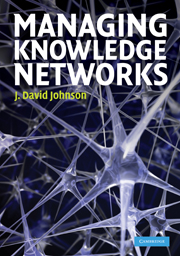3 - Network analysis
Published online by Cambridge University Press: 05 June 2012
Summary
Network analysis is a highly systematic means of examining the overall configuration of relationships within an organization. The most common form of graphic portrayal of networks contains nodes, shown by circles in Figure 3.1, which represent social units (e.g., people, groups), and relationships (reflected in the lines) of various sorts between them. These elements of graphic representations are essential to most network analysis definitions: “In general, the term ‘network’ is taken to mean a set of units (or nodes) of some kind and the relations of specific types that occur among them” (Alba 1982, p. 42, italics in original).
Because of its generality, network analysis has been used by almost every social science to study specific problems. Network analysis has been the primary means of studying communication structure in organizations for over three decades (Farace, Monge, and Russell 1977) and has become increasingly popular in management and organizational sociology as well (Borgatti and Foster 2003). In fact, so much attention has been paid to network analysis that a comprehensive review, particularly related to data gathering methods (Box 3.1) and computer programs (Box 3.2), of all material linked to it is beyond the scope of this chapter.
Naturally our focus here is on issues fundamental to KN, which will be developed in much more detail in subsequent chapters. Social networking technology is viewed as a key feature of contemporary business approaches to how knowledge spreads within a company (Cross, Parker, and Sasson 2003; Waters 2004). Since networks provide organizations with access to knowledge, resources, and technologies, they are a key source of competitive advantage (Inkpen and Tsang 2005).
- Type
- Chapter
- Information
- Managing Knowledge Networks , pp. 25 - 54Publisher: Cambridge University PressPrint publication year: 2009



